Rubber cuff for a toilet bowl (cam): rules of installation and connection
Connecting the toilet to the sewer does not require special knowledge and skills, however, during installation, you may encounter difficulty in the form of a mismatch between the central axes of the release of the plumbing fixture and the sewer drain pipe.
Holes that are at different levels or offset to the side will help connect the toilet cuff - eccentric or corrugated.
We will show you how to choose the right product and install it. There are no particular difficulties, the main thing is to take into account the design of the toilet itself and follow the instructions below. To facilitate the task and improve understanding of the installation process, we supplemented the information with visual photographs and thematic video clips.
The content of the article:
Classification of toilet cuffs
The cuff is a simple but necessary plumbing element responsible for the tight connection of the toilet to the sewer outlet. It is mandatory when installing any type of floor device. This means that with choosing a compact toilet and buying it, you must immediately purchase a cuff.
The items on sale differ in the material of manufacture, diameter, shape, so before buying, you should find out some points of connection. For example, you need to know the diameter of the sewer pipe to which one end of the cuff will be attached. D 110 mm is standard, but deviations from the norm may occur.
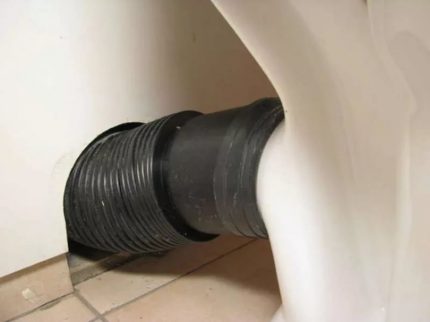
You should also clarify the type of toilet outlet and its diameter, since the second end of the cuff will be attached to it. Size mismatch possible.
The problem is solved using one of the cuff types:
- with direct connection - simple conical model;
- when connected with offset - combined with different sizes of outputs.
In difficult cases, when a toilet with a sewer outlet is at different levels relative to the floor or is shifted along the axis, it is easier to use a more elastic type of cuff - a corrugated pipe, which has two smooth tips and a flexible central part that can stretch, change its shape and length.
So, if we generalize all types of cuffs, then we can distinguish the following groups:
- straight smooth;
- angular smooth;
- conical;
- eccentrics;
- corrugated.
You can find combined types - for example, on the one hand smooth straight lines, on the other corrugated.
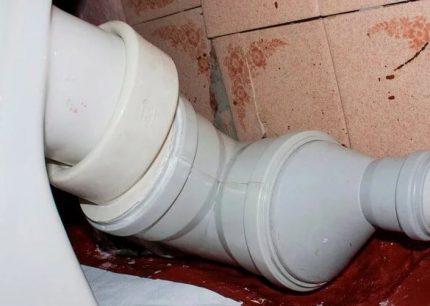
According to the material of manufacture, all cuffs are divided into two groups:
- Plastic. Suitable for modern models of toilets and plastic sewer pipes.
- Rubber. Used to connect to a cast iron pipe.
The color of the material does not mean anything, manufacturers usually produce white, gray or black products.
Selecting an outlet-oriented adapter
In addition to dimensions that are of paramount importance, it is necessary to take into account the design features of the toilet, namely the form of release.
It is of three types:
- vertical
- horizontal
- oblique.
Vertical release
In Russia, it is used extremely rarely, since the location of sewer pipes above the floor level contradicts such a device. The vertical outlet is designed for drainage to be at floor level, and the pipes themselves are sewn up in the ceiling or placed under the floor.
If installation is still required upright toilet, it is appropriate to use a straight short plastic cylindrical cuff. Eccentrics or complex configurations are not required because a vertical-flush toilet is placed directly above the sewer drain.

Horizontal release
This option is much more common and is an element of the toilet, perpendicular to the wall. Ideally, it should be just opposite the inlet of the sewer pipe.
In this case, a smooth plastic cuff of small length or an element with two cylinders at the edges and a corrugated middle is suitable.
If the house is old, and the pipes still have not changed (a rare case), then you will need a rubber cuff for a compact toilet, which is used to connect to cast-iron pipes. When the axes of the input-output are shifted in height, an eccentric is useful - either smooth or with a corrugated pipe.
If the distance to the pipe is significant, sometimes use a corrugation, stretching it to the desired length, and an eccentric for a more tight connection.

As you can see, when connecting a plumbing fixture with a horizontal outlet, various types of cuffs can be used.
Oblique release
Such toilets are also connected in different ways, depending on the location relative to the drain sewer.
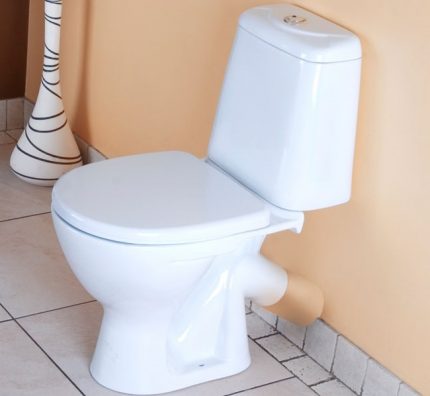
If the entrance / exit are located on the same level, it is better to buy a sanitary equipment with a horizontal outlet.
At connecting oblique release short plastic cylindrical elements are also suitable if the toilet is mounted next to the pipe, and longer products with corrugation if the plumbing fixture is located at some distance from the sewer drain hole.
A rubber cuff is also necessary only in one case - if you need to attach the toilet to an old-style cast-iron pipe.
Mounting instructions for various types of cuffs
The principle of fixing rubber or plastic, smooth or corrugated parts is similar, but the process itself may differ in nuances - from choosing the place to install the toilet to using additional mounting methods. Consider three common connection options.
# 1: Install rubber seal
A rubber cuff is a short, tight element that is not pulled from the outside, but inserted into the socket of a cast-iron pipe. This is a kind of seal or gasket, creating a tight connection between the drain hole and the plumbing fixture.
In addition, it protects sanitary ware from chips and damage in case of unintentional violation of installation stability.
Procedure for installing the rubber cuff:
If the toilet outlet enters the socket freely, then a soap solution will not be needed. On the contrary, it is necessary to create a denser abutment.
To do this, they usually use the traditional modern method - a sealant is applied over the entire surface of the adjacent parts. After solidification, it forms a tight hermetic ring.
# 2: Rules for using the cam
The fact that you need an eccentric, you will learn at the stage of choosing a place to install the toilet. If the outlet of the plumbing fixture and the socket of the sewer pipe are not strictly opposite each other, a simple plastic connector is not enough. Axis displacement requires a curved part.
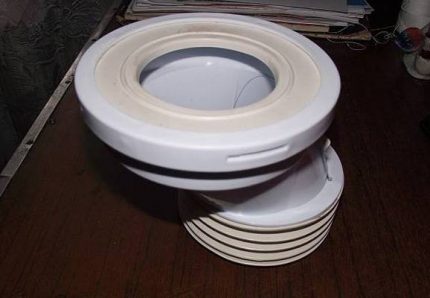
Before installation, it is necessary to put the plumbing device in place, measure the length to the sewer drain and once again make sure that the model of the eccentric for the toilet bowl is selected correctly. To check, you can simply put the part to both holes.
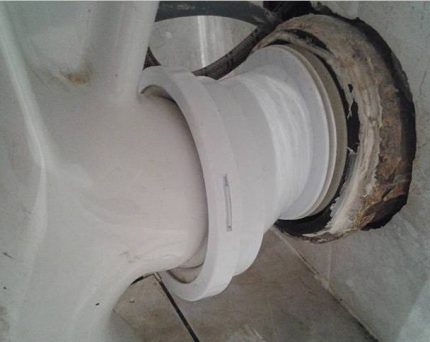
Work order:
- we clean the sewer inlet from old deposits;
- we put the cuff with a wide end (110 mm) on the sewer bell, coating the places of abutment with sealant;
- the second end is connected to the oblique or horizontal outlet of the toilet bowl, also using sealant;
- we make trial descent of water;
- if no leaks are detected, we fix the toilet bowl in a previously prepared place with bolts.
The problem arises when during installation it turns out that the eccentric is incorrectly selected. To avoid an uncomfortable situation, instead of a rigid structure, you can immediately buy a part with an elastic corrugated middle.
As necessary, the eccentric with the "accordion" can be slightly shifted to the right / left or slightly stretched, while maintaining its functional qualities.
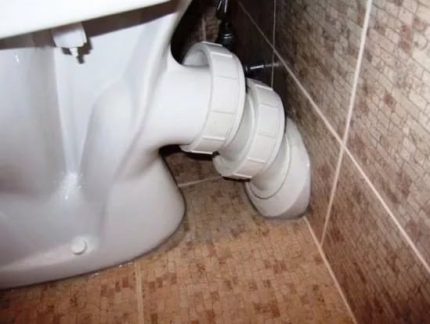
Moving parts are also relevant when there is a risk of fragile toilet fixation. Simply put, when you swing the plumbing fixture, the tightness of the rigid connection will immediately be violated, while this does not threaten the corrugation.
# 3: Installing the corrugated cuff
The code is difficult to install the toilet in connection with the inappropriate form of release or the complex location of the sewer, often using an elastic corrugated pipe. Its advantage is that it can easily change shape and length, therefore, suitable for almost all types of releases.
The only things to consider when buying are the diameters of the locking cylindrical ends. They can be 110 mm / 90 mm, 110 mm / 80 mm, etc.
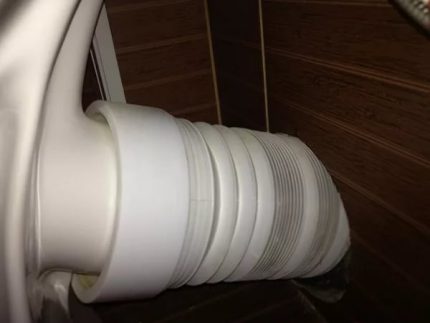
Replacement principle or corrugation installation same as other types of cuffs:
- removal of an old worn item;
- cleaning inlets from dirt and deposits;
- inserting the sealant-treated end into the sewer socket;
- fixing the second end on the toilet;
- trial descent of water, elimination of defects.
Experienced plumbers recommend not stretching the corrugation to the maximum, since as a result of this, it loses elasticity and quickly fails.
It is better to choose a model of a larger length or try to move the toilet closer to the outlet. Another option is to buy a combination cuff, which is partially made up of hard elements.
Adapter Mounting Tips
Before choosing a cuff, be sure to check the distance from the toilet outlet to the sewer pipe. Sometimes the installation process is violated only due to the fact that the length of the eccentric is 2 cm less than necessary.
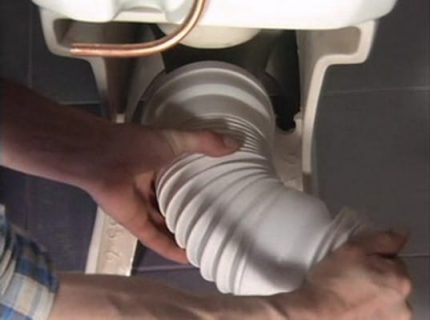
The elongated corrugation is prone to sagging, so additional fasteners will be required to give it a direct look. Sharp angles and strong bends are the causes of frequent blockages.
In addition to the length and shape of the cuffs, pay attention to the wall thickness. The higher this indicator, the longer the device will last.
Before buying plumbing, analyze the condition of the sewer system, and then you can choose a model with the desired type of release and decide on toilet installation.
Conclusions and useful video on the topic
The secrets of the correct choice and use of plumbing cuffs can be found in the following videos.
Use for connecting a corner cuff:
Plumbing tricks when using adapters and cuffs:
The cuff mount is part of the toilet installation process. If you correctly decide on the choice of a connecting element, the installation of plumbing will not take much time and will not cause difficulties.
If you have any difficulties, we recommend that you seek help from specialists. Timely consultation before buying a cuff also does not hurt.
Do you have practical skills in installing, connecting a toilet and mounting a cuff? Please share your knowledge or ask questions on the topic in the comments. The communication unit is located below.

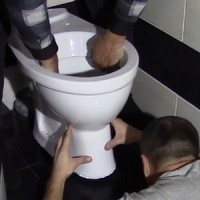 Do-it-yourself toilet installation: features of mounting toilet bowls of various designs
Do-it-yourself toilet installation: features of mounting toilet bowls of various designs 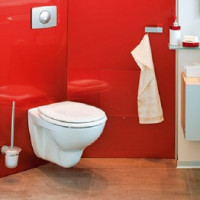 Corner installation for a toilet: selection tips and installation rules
Corner installation for a toilet: selection tips and installation rules 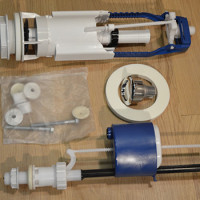 Valve for toilet: types of valves and features of their installation
Valve for toilet: types of valves and features of their installation 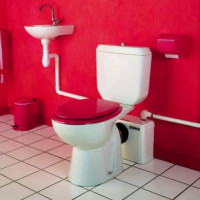 Toilet chopper pump: device, principle of operation and installation rules
Toilet chopper pump: device, principle of operation and installation rules 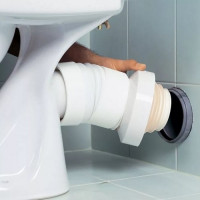 Installing the corrugation on the toilet and the specifics of connecting plumbing with it
Installing the corrugation on the toilet and the specifics of connecting plumbing with it 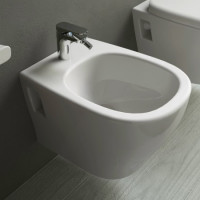 DIY bidet installation: specifics of installation and connection to communications
DIY bidet installation: specifics of installation and connection to communications  How much does it cost to connect gas to a private house: the price of organizing gas supply
How much does it cost to connect gas to a private house: the price of organizing gas supply  The best washing machines with dryer: model rating and customer tips
The best washing machines with dryer: model rating and customer tips  What is the color temperature of light and the nuances of choosing the temperature of the lamps to suit your needs
What is the color temperature of light and the nuances of choosing the temperature of the lamps to suit your needs  Replacement of a geyser in an apartment: replacement paperwork + basic norms and requirements
Replacement of a geyser in an apartment: replacement paperwork + basic norms and requirements
I just have a corrugation on the toilet. Thought to change, but why? It copes with its tasks, water does not leak anywhere, everything is tight and isolated. For me, there’s no difference at all, the main thing is that it is convenient to install and disassemble if that.
In such cases, once again I am convinced of the proverb: "There is nothing more permanent than temporary." But the corrugation is not a temporary solution, to be honest, the service life that is laid in it is at least a dozen years. If you do not violate the installation rules, then there should be no problems. For example, when installing the toilet, the corrugation length is not enough and it is stretched to the maximum, which significantly reduces its elasticity properties. You do not need to do this, it is better to buy with a margin of length.
And also the classics from the genre “will do so” when they have not guessed with the diameters and people begin to sculpt a bunch of strange adapters. I enclose a photo, how to do it is definitely not worth it!